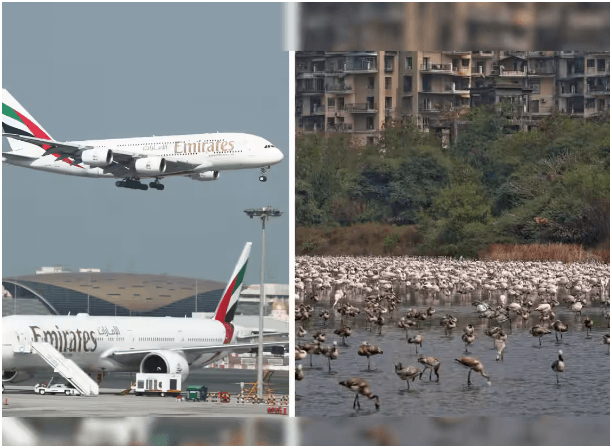Emirates: Aircraft and Passengers Safe After Flamingo Incident
An Emirates aircraft collided with a flock of flamingos near Mumbai airport, resulting in the deaths of 39 birds. This unprecedented event, which occurred on Monday evening, is under rigorous investigation by both aviation and wildlife authorities to understand the dynamics of the collision and prevent future occurrences.
The Emirates Boeing 777, operating flight EK 508 from Dubai, was on its final descent to runway 27 at Mumbai’s Chhatrapati Shivaji Maharaj International Airport. Around 8:30 pm, as the aircraft was about a minute from landing, it flew into a flock of Lesser flamingos at approximately 1,000 feet over Laxmibaug in Ghatkopar East. The plane was reportedly cruising at a speed of 280 km/h when the collision occurred.
Despite the significant impact, the aircraft landed safely, and all passengers and crew disembarked without injury. Emirates confirmed the safety of everyone on board, emphasizing the robust safety protocols and the skill of the flight crew in handling the situation. Flamingo migrations to Mumbai have been a regular occurrence since the 1990s, while the city’s airport has been operational since the 1940s.
This marks the first major incident involving a collision between aircraft and flamingos in the area. The flamingos were reportedly en route to Kutch, their natural habitat. This collision is reminiscent of the US Airways Flight 1549 incident in 2009, where a bird strike involving Canadian geese led to an emergency landing in the Hudson River. Such incidents highlight the ongoing challenges of managing airspace intersecting with wildlife migratory paths.
The investigation, led by both aviation and wildlife authorities, aims to uncover the precise circumstances leading to the collision and implement measures to mitigate such risks in the future. Possible measures include adjustments to flight paths, enhanced radar technology to detect bird flocks, and coordination with wildlife experts to better understand migratory patterns. Various stakeholders, including Mrugank Prabhu, Sneh Bagwe, Dipali Lokhande, and Pritesh Modi, are involved in the probe, which is expected to yield insights that could improve aviation safety and wildlife conservation. This incident underscores the delicate balance required in urban ecosystems where human and wildlife activities intersect.
As aviation and wildlife authorities continue their investigation, this event serves as a stark reminder of the potential conflicts between human activities and natural wildlife movements. Enhanced awareness and innovative solutions will be key to preventing similar occurrences in the future, ensuring the safety of both air travel and the region’s rich biodiversity.
Following the bird strike, the flight crew executed established safety procedures. They performed a thorough check of the aircraft systems and maintained communication with air traffic control. Given the situation, Captain Al Habsi made the decision to return to Dubai International Airport as a precautionary measure.
The aircraft, an Airbus A380, circled the airport to burn off fuel, which is a standard procedure to reduce landing weight and ensure a safe landing. During this time, the crew kept passengers informed and reassured, maintaining calm and order in the cabin.
After circling the airport, Flight EK719 made a safe landing back at Dubai International Airport. Emergency services were on standby as a precaution but were not needed. Passengers were safely disembarked and transported back to the terminal, where they were provided with refreshments and information regarding their rescheduled flight.
An Emirates spokesperson praised the crew’s handling of the incident: “The safety of our passengers and crew is always our top priority. The swift and professional actions of the flight crew ensured a safe outcome. We are grateful for their expertise and the understanding of our passengers.”
Following the safe landing, the aircraft underwent a comprehensive inspection by Emirates’ engineering team. Bird strikes can cause damage to aircraft engines, wings, and other critical components, necessitating a thorough examination to ensure airworthiness.
Initial reports indicated minor damage to one of the engines and the Emirates aircraft’s exterior. Emirates engineers worked quickly to assess and repair the damage, coordinating closely with Airbus representatives. The aircraft is expected to return to service following the completion of necessary repairs and safety checks.
Bird strikes are a known hazard in aviation, and airports around the world implement various wildlife management strategies to mitigate the risks. Dubai International Airport employs multiple measures to deter birds from the airfield, including habitat management, the use of bird-scaring devices, and regular monitoring.
